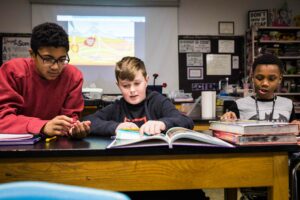Schools implementing the CTL Adolescent Literacy Model (ALM) have committed to improving literacy outcomes for all students through focused, intentional work in every classroom, regardless of content area. As a whole-school model, common strategies that lead to improved reading, writing, speaking, and listening are implemented across classrooms. However, within those classrooms there are a variety of students with different needs, so sometimes the ALM strategies may need to be differentiated or adapted to meet the various needs of learners, including those identified as gifted and talented. As teachers strategically select ALM strategies for their lessons, they can simultaneously plan modifications for their students identified as academically gifted.
Differentiation for gifted learners can happen through changes in content or in what they are asked to do with content. For example, if the whole class is reading an informational text about lunar phases, gifted learners could either be provided a different, more complex text about the same topic and then engage in the same Reading Comprehension strategies as the others. Alternatively, the strategies used for engaging with the text could be different for gifted learners, for example as the rest of the class uses text codes with margin notes to engage with a next text, gifted students could complete an It Says-I Say-And So organizer to push them to think more analytically. Tiered assignments are another way to differentiate by allowing choices for the gifted learner because they can be constructed with different ways for students to demonstrate their understanding of the concepts studied or they can include base assignments for all with established extension activities for gifted learners.
If there are multiple gifted learners in the same class, grouping gifted students together for some lessons can allow them to work together on either content that is differentiated for them or on more challenging tasks planned at a higher level. Gifted learners might be intentionally grouped for any Academic Dialogue strategy, such as Paired Verbal Fluency, Think-Ink-Pair-Share, or Café Conversations, with different expectations for their level of discussion. Another example is grouping gifted learners together to collaborate on Writing to Learn or Writing to Demonstrate Learning prompts that push their thinking and require them to engage in deeper analysis or propose creative solutions to a problem.

A third example of an appropriate modification for gifted learners is curriculum compacting. Through pre-assessment, teachers can determine if learners are demonstrating comprehension or mastery of content already. If so, there is no benefit to having them continue with the lesson as already planned – they have shown they are ready for more. This could be applied to work on Vocabulary Development, for example. If gifted learners are already able to understand and correctly use the vocabulary introduced to the rest of the class, they may need additional terms and phrases that are new to them but still aligned with the standards and content, such as language that is more technical or abstract in nature. Gifted students in the class might be given the opportunity to select their own personalized vocabulary sets and create entries for the Interactive Word Wall. Then, with this differentiated content, they can engage in the same strategies for Vocabulary Development utilized with the rest of the class. Another way for teachers to provide curriculum compacting is through the choice of reading materials. If gifted students have already demonstrated content mastery, then they could read material that dives more deeply into the content or that is more complex, such as primary sources or technical writing.
These are just a few examples of ways to marry the strategies of the Adolescent Literacy Model with strategies for meeting the needs of gifted students in heterogeneous classrooms recommended by The National Association for Gifted Children (NAGC). It is important to remember that gifted students need different work from their peers, not more work, so adapting the ALM strategies the whole class will use is an ideal way to meet the needs of gifted students. As teachers experiment with these kinds of modifications, they should share with their colleagues in PLC, team, and department meetings so that a collection of effective practices for adapting instruction for learners with different needs can be developed, shared, and implemented school-wide.
